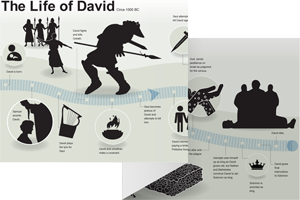8:1–14 This section summarizes the wars that occurred during David’s reign. The list is not necessarily all-inclusive (other campaigns are listed later), nor in chronological order. It seems to narrate David’s victories over enemies in the west (Philistines), the east (Moabites), the north (Aram), and the south (Edom). The overall intent is to show that Yahweh gives David success (2 Sam 8:6, 14), and the victories he achieves secure his borders in all directions. |
8:1 David attacked the Philistines This brief description represents the cessation of the Philistine threat for a portion of David’s reign. See 7:1 and note.
8:2 Moab David attacks the Moabites even though they had formerly shown kindness to him and were his distant relatives (1 Sam 22:4; compare 1 Chr 18:2).
even though they had formerly shown kindness to him and were his distant relatives (1 Sam 22:4; compare 1 Chr 18:2).
 Battles of Saul and David Table
Battles of Saul and David Table
with the cord The line was long enough to cover three men, and two out of the three were put to death. He left some alive in order to collect tribute from them, but he killed enough so that they no longer posed a military threat to his eastern border.
tribute Refers to taxes levied against a conquered people.
8:3 Zobah A northern enemy in the region of Syria, north of Damascus and south of Hamath. Saul had earlier fought against Zobah (1 Sam 14:47).
north of Damascus and south of Hamath. Saul had earlier fought against Zobah (1 Sam 14:47).
monument The Hebrew word used here, yad, may refer to a monument, or more generally to power or control. In the Hebrew text it is unclear whether David or Hadadezer is performing this action. If it was David, he may have erected a monument on his northern border (compare 1 Sam 15:12; 2 Sam 18:18). This would have alerted travelers that they were about to enter into his kingdom.
8:4 David hamstrung all the chariot horses By doing so, David ensures they cannot be used against him in battle.
8:6 garrisons in Aram of Intended to police the region and prevent rebellion.
8:9 Hamath Like Zobah, Hamath was located in the region of Syria.
8:10 to greet him A politically beneficial move; Tou (or Toi) makes peace with David and offers gifts commemorating David’s military victories.
8:11 dedicated them also to Yahweh David also dedicates the gold shields of Hadadezer’s servants to Yahweh.
8:13 a name The Hebrew text here speaks of making a name for oneself, which in the ancient Near East can refer to the establishment of a monument. See 7:9 and note; note on v. 3.
8:14 garrisons in Edom See v. 6 and note.
8:15–18 This chapter closes by listing David’s cabinet (compare 20:23–26). |
8:15 administering justice and righteousness The hallmark of a noble ruler.
8:16 Joab David’s nephew (see 2:13 and note).
8:17 Zadok See note on 1 Sam 2:35; Ezek 40:46 and note.
Ahimelech the son of Abiathar This may be a scribal error. Ahimelech is the priest of Nob who gives David holy bread and a sword (1 Sam 21:6, 9)—prompting Saul to order the slaughter of all the priests of Nob (1 Sam 22:18). The lone survivor is Ahimelech’s son Abiathar (1 Sam 22:20), who becomes David’s priest (1 Sam 30:7). Two later lists of David’s officials have Abiathar instead of Ahimelech (2 Sam 20:25; 1 Kgs 4:4).
8:18 Kerethites and the Pelethites Foreign mercenary troops comprising the royal bodyguard (2 Sam 23:22–23).
the sons of David were priests Even though David was not from the tribe of Levi, his sons are named with the typical Hebrew word for a priest, kohen. For this reason, some translations use “ministers” here to indicate that they were not Levitical priests but served as royal advisors or administrators (compare 1 Chr 18:17).

|
About Faithlife Study BibleFaithlife Study Bible (FSB) is your guide to the ancient world of the Old and New Testaments, with study notes and articles that draw from a wide range of academic research. FSB helps you learn how to think about interpretation methods and issues so that you can gain a deeper understanding of the text. |
| Copyright |
Copyright 2012 Logos Bible Software. |
| Support Info | fsb |
 Loading…
Loading…


